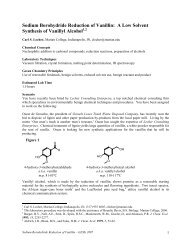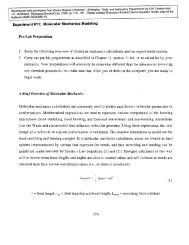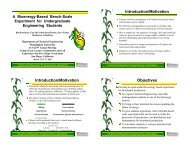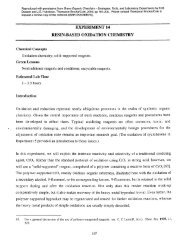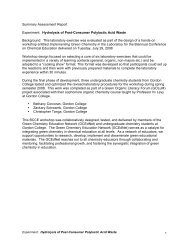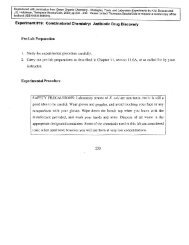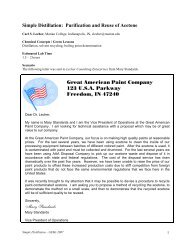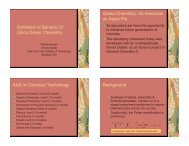Power Point Presentation (PDF) - Green Chemistry Center
Power Point Presentation (PDF) - Green Chemistry Center
Power Point Presentation (PDF) - Green Chemistry Center
Create successful ePaper yourself
Turn your PDF publications into a flip-book with our unique Google optimized e-Paper software.
Going <strong>Green</strong> at the University of OregonLessons Learned:Breaking the BarriersKenneth M. DoxseeJames E. HutchisonDepartment of <strong>Chemistry</strong>University of OregonEugene, OR 97403Doxsee@uoregon.eduHutch@uoregon.eduThe Oregon <strong>Green</strong> <strong>Chemistry</strong> <strong>Center</strong>Promoting sustainable chemistry through research and education• Establish top-ranked training programs in green chemistry<strong>Green</strong> organic laboratory curriculum<strong>Green</strong> curricula in Instrumental Analysis, Physical <strong>Chemistry</strong>, and General<strong>Chemistry</strong> (honors)• Develop infrastructure for green chemistry education/researchShowcase green chemistry instructional laboratoryState-of-the-art instrumentation center• Promote green chemistry education and researchDissemination through WWW, textbook, and workshopsInterdisciplinary training program at Master’s levelThe Oregon <strong>Green</strong> <strong>Chemistry</strong> <strong>Center</strong>Evolution of the <strong>Green</strong> LaboratoryPromoting sustainable chemistry through research and education• Facilitate exchange of green chemistry expertise with industrialpartnersInternship programShowcase industrial/academic achievements in green chemistry andmanufacturing• Highlight ongoing research in green chemistry at the U of OPre 1992: capacity ~ 60Pre 1992: capacity ~601992 - present: capacity = 18Pre 1992: capacity ~ 601992 1992 - present: - 2001: capacity capacity = 18 18
Evolution of the <strong>Green</strong> LaboratorySustainability“Human beings are at the center of concerns for sustainabledevelopment. They are entitled to a healthy and productivelife in harmony with nature.”Principle 1 of the Rio Declaration onEnvironment and Development(Rio de Janeiro, 3-14 June 1992)2001 - present: capacity 48Academic Barriers to a <strong>Green</strong> CurriculumPedagogical Concerns“The curriculum will not train students to work with hazardousmaterials.”
Who are our Clientele?Pedagogical Concerns“The curriculum will not teach students what they need to know foradmission to graduate school or for standardized examinations.”Most students will not work with hazardous substances.Proper technique can be learned with safe substances.Academic Preparation*Traditional <strong>Green</strong>Fundamentals of chemistry + +Practical lab procedures + +<strong>Green</strong> chemical concepts - +Process chemical concepts - +Waste generation/disposal - +Safety + +Realistic scale and apparatus +/- +State-of-the-art curriculum - +“<strong>Green</strong> is political, not scientific.”Skepticism“<strong>Green</strong> is a passing fad. It is hippiechemistry.”“<strong>Green</strong> chemistry is not rigorous.”* Late 1800’s, periodically updated with new experiments New experiments, designed to illustrate key chemical and green issues
Process ResearchState-of-the-Art ExperimentationDesigning better products and better processes is whatsynthetic chemists do. <strong>Green</strong> chemistry is intrinsicallymore rigorous than traditional chemistry due to theimposition of significant “boundary conditions.”ROXOHR = X = HR = H, X = OCH 3 (vanillin)R = CH 3 , X = HKINaOClEtOH/H 2 OROXIOHOHH C C C CH 3CH 3Pd(OAc) 2 /TPPTSNaOAci-PrOH/H 2 OROXOOHC CH 3CH 3R = X = H (spruce rot fungus)R = H, X = OCH 3 (?)R = CH 3 , X = H (giant tree daisy)Electrophilic halogenationPd-catalyzed couplingAlkyne chemistryNatural product synthesisSafer reagentsAlternative solventsCatalysis<strong>Green</strong> Teaching Materials“There aren’t green chemistry materials available.”<strong>Green</strong> <strong>Chemistry</strong> in Education WorkshopJuly 23-28, 2005http://chemistry.gsu.edu/CWCS/green.php<strong>Green</strong>ing Across The <strong>Chemistry</strong> Curriculum
Course Content OverloadInertia“There’s already too much to teach; I can’t possibly add morecontent to my courses.”“We’ve always done it this way.”“We just revised our curriculum when we converted tomicroscale.”Replacement vs. addition of materialBenefits of a <strong>Green</strong> CurriculumWaste StreamWe are generating less waste and a less hazardous wastestream.180 students14.2 L aqueous waste (80 mL/student)1 L flammable organic waste (6 mL/student)1 kg solid waste (6 g/student)
Desirable Lab SettingPositive Student Response• Objective evaluation of hazards• Rational procedure for analyzing/minimizing hazards• Empowers students to use chemistry to solve environmentalproblems - "Ambassadors of <strong>Green</strong> <strong>Chemistry</strong>"• Changes the way students and society view chemicals, chemistryand chemists - not all chemicals are hazardous"After taking this course I have a much better opinion of chemistry .... I feel like I amlearning something that has an actual important application to the real world.""I have decided to get a minor in chemistry so I can make more conscious decisionsregarding chemistry and avoid destructive practices for my health or the environment."Energy Cost SavingsEnhanced SafetyAir handling, HVACHow to Use a Fume HoodAdjust the sash. Position sashes at the arrows to ensure proper airflow velocities at the work opening. Adjust the sash to shield yourselffrom splashes or flying objects. Horizontally sliding sashes can be used as a body shield by wrapping your arms around the sash panelas you work.Check that the hood is working properly.Keep all work at least 6 inches inside the hood. The capture ability of a fume hood may not be 100% at the front of the hood.Never lean your head inside the fume hood when chemicals are present.Avoid cross drafts. Someone walking rapidly past the work opening can create a cross draft that may disturb the direction of airflowand cause turbulence.Prevent pollution. The chemical vapors generated in most hoods are exhausted into the atmosphere. To minimize pollution, seal allchemical containers not in use. Never use the hood to vent excess chemical waste. By law, all chemical containers must be cappedwhen the hood is not operat ing.Do not heat perchloric acid in standard fume hoods. Perchloric vapors may create explosive perchlorates in the ductwork. ContactEH&S if you are performing perchloric acid digestions.Do not adjust the damper. Doing so may adversely affect fume hoods in other rooms. Users may adjust the baffles based on the vaporpressure of the materials being used.http://www.ehs.berkeley.edu/pubs/factsheets/09fumehd.html
Public RelationsFund Raising OpportunitiesOrganic <strong>Chemistry</strong> Goes for the <strong>Green</strong>Alice C. Tyler Perpetual TrustGlobal ImpactsNo Need for Expensive RemodelingMexicoProf. Mtro. Arturo Fregoso Infante, CoordinatorCentro Mexicano de Química en MicroscalaUniversidad IberoamericanaProl. Paseo de la Reforma 880Lomas de Santa FeCuidad de México, D.F. 01210MéxicoDr. Jorge G. IbanezCentro Mexicano de Química en MicroescalaDepartamento de CienciasUniversidad IberoamericanaProlongacion Paseo de la Reforma 880Delegacion Alvaro ObregonCuidad de México, D.F. 01210MéxicoTel: 52 55 5267 4176 or 52 55 5267 4074Fax: 52 55 5267 4279 or 52 55 5267 4063Email: jorge.ibanez@uia.mxNepalChapter UpdateMr. Ramesh Kr. SilwalNepal Chemical SocietyG.P.O. Box No. 6145Kathmandu, NepalTel: 977-1-536-162Fax: 977-1-474-851E-mail: whitehouse@mail.com.npThe Nepal chapter focused on institutional infrastructure.They held a training session on microlevel experimentaltechniques for 26 chemists. Nepalese professors whoattended the University of Oregon green chemistryworkshop organized a roundtable to disseminate theirnew perspectives to other Nepalese chemists. In 2003,they plan to hold a symposium to raise awareness aboutgreen chemistry among popular media, academics,industry, and government participants.
Summary - BenefitsSummary - BenefitsPreparation to meet challenges of modern chemical (andchemistry-related) industriesReduced hazards of waste streamReduced health and environmental impactProvision of modernized laboratory experienceState-of-the-art experimentsRealistic apparatusRealistic scaleNo need for expensive renovationsAppreciable cost savingsResponsible trainingAbility for critical assessmentPublic RelationsImproved perception of chemistryStudent recruitment (undergraduate, graduate)Community relationsState relationsFunding opportunitiesConclusionIt’s easy to find excuses.If you push hard enough, even a donkey will move.




